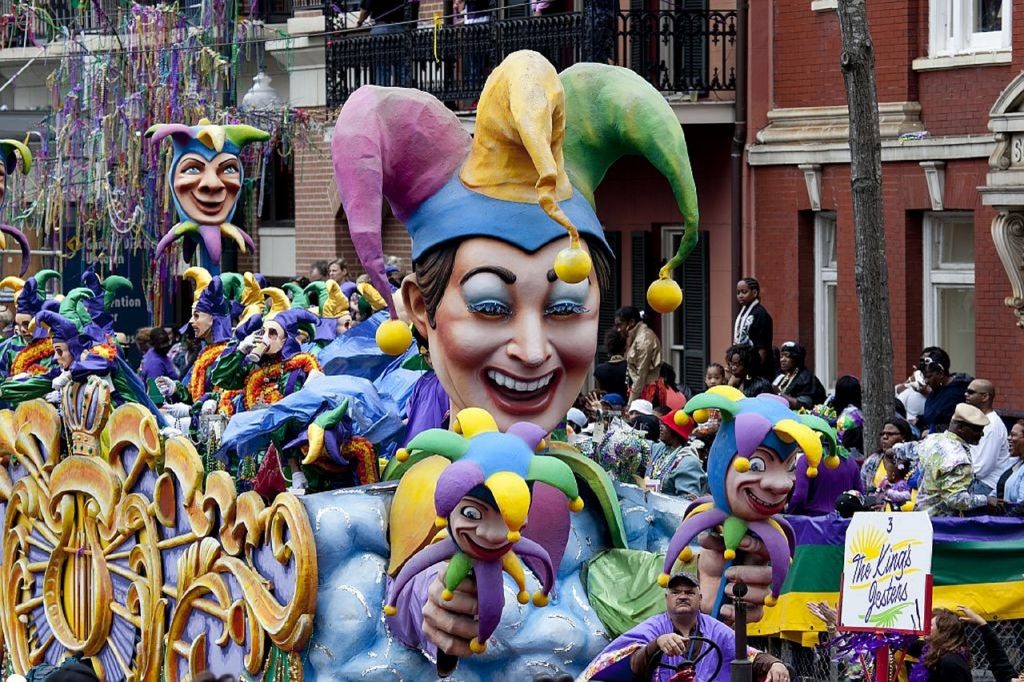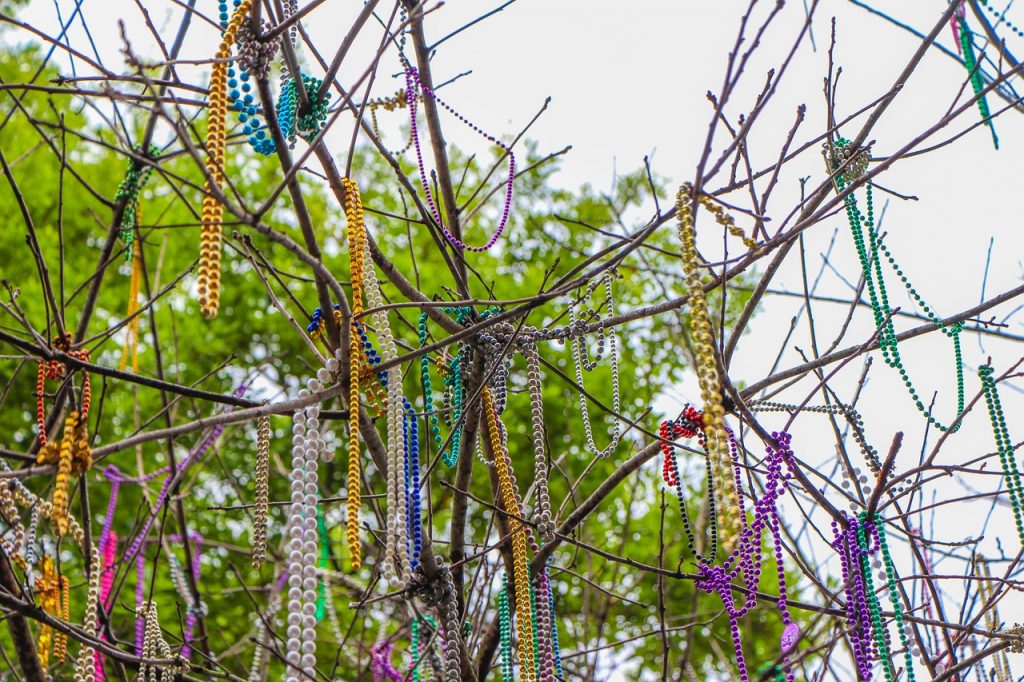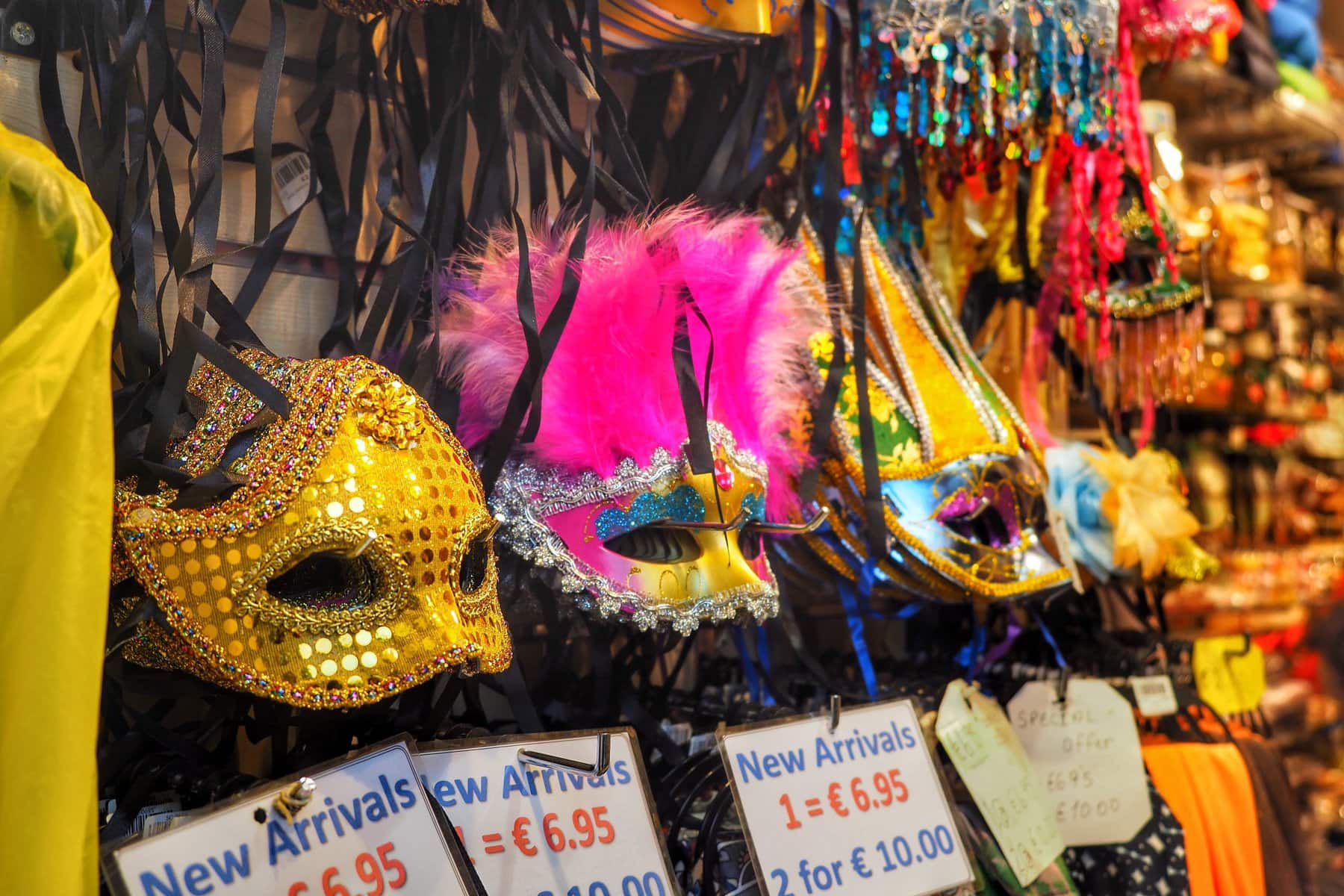Whether you’ve recently moved to New Orleans or are just hoping to hit the nation’s biggest party, Mardi Gras means more than just booze, beads, and boobies. What most non-locals don’t know is that Mardi Gras is, at its roots, a holiday entrenched in family traditions and history; and it’s well-worth the trip to experience it!
Mardi Gras History
In order to truly understand Mardi Gras, it’s important to know a bit of its history. Mardi Gras started in the second half of the 1800s with the formation of secret societies known as Krewes. A very little-known fact outside of New Orleans is that the first Mardi Gras parades were actually held in Mobile, Alabama. Lucky for us, the tradition moved on to the Big Easy! In early days, parade floats were pulled by mules and lit by torches known as flambeau. Kings and Queens of each Krewe were chosen in secret and often reflected societal status. Mardi Gras literally means “Fat Tuesday” in French, which is why it is often referred to by both names, along with the general term “Carnival.” The actual terms date back to Catholic traditions and Latin roots, where “carne valle” meant “Farewell to flesh” and was the last opportunity for worshippers to enjoy meat and other feasting before the start of Lent and a season of penitence and fasting. This is why most bigger or more traditional parades will feature a Beauf Gras or fattened calf as a symbol of the religious origins of the festival. Tableaux balls were often held at night, with the oldest of Krewes holding theirs in strictest secrecy.
Over the years the parades have shifted, moving from the French Quarter to other areas of the city and beyond as leaders feared another great fire in the tight streets of the city center. Parades have also modernized, employing fiber-optic lights and tractors to pull floats. Traditional flambeau are still present, but they are there in a more ceremonial role now. The creation of super-krewes have also changed the look of Mardi Gras, incorporating bigger and longer floats and Krewes numbering near 1000 members.
But despite changes, Mardi Gras remains a New Orleans staple that families have enjoyed for generations. If you’d like to start your own Mardi Gras traditions, read on to find out how to navigate the parades like a native!
Know the Basics
Running the streets of New Orleans like a local means knowing the terms that will keep you from looking like a tourist. Krewes are the groups the hold the parades. To be a member of a Krewe you need to pay dues and often be invited through various routes of friendship or genealogy. The dues paid help to build the floats that Krewe members will ride on during the parades. Members must provide their own “throws,” which include cups, stuffed animals, cheap toys, and–of course–the beads. Individual krewes will also have specialty items that become collectors’ items, such as shoes from Muses or the infamous painted coconuts of Zulu.

Parades are held throughout New Orleans, but the main routes threat through Downtown and Uptown. Routes can be found online and in newspapers and magazines prior to the start of carnival season. Many families will have traditional spots where they’ve set up for generations. You’ll see folks start to stake out their territory even days before parades start. Plan to be in it for the long haul if you intend to do this–if you’re not there you can’t guarantee your spot! The one place you won’t find any parades is the French Quarter. The most infamous area of New Orleans is parade-free. If you’re feeling adventurous, go ahead and take a trip to Bourbon Street to experience the debauchery, but leave the kiddos at home for that one, and be ready to be stepped on, squashed, locked in place for hours, and worse. Bourbon Street is where all the tourists go for Mardi Gras; the locals know to stay far, far away.
Other terms to know are the Mardi Gras King and Queen. Each parade has one, but the official king of ALL Mardi Gras is Rex. He has his very own parade on Mardi Gras day and is known as the King of Mardi Gras, the Monarch of Merriment. He crosses the Mississippi River on Lundi Gras (Fat Monday) and receives the keys to the city, thus giving him control of the Crescent City until Midnight on Fat Tuesday when the party ends and Ash Wednesday begins. While the king is the figure head of each parade, the Captains are the real officials of each Krewe. They ride at the front of each parade and are often the only members to throw doubloons–special coins particular to each parade.
What You’ll See
In addition to Kings, Queens, and Captains, each parade has local bands and dance groups, often from area high schools. The bigger the parade, the bigger the bands. Some bands have unrivaled reputations and provide outstanding music–just stand back because they will walk right through you in order to stay in formation! You will also see attendants. These are the “debutants” of the parade, often sons and daughters of higher-ranked Krewe members.
The parades themselves have a theme, kept secret until the day or night of the parade. These themes often relate to contemporary issues such as politics, or sports, but can also reflect other areas such as children’s books, extinct animals, or even Mardi Gras history. Each float tells a piece of the story so pay attention!
Parade riders will always be masked. In the olden days, Krewes were completely secret societies, and exclusively white and male. Zulu became the first Black parade, poking fun at the stereotypes of the day. While some Krewes remain exclusive (these Krewes are banned from parading) and only hold balls, most Krewes are now open to anyone, to include coed Krewes and all-female Krewes. Many members will even let friends and family know which float number and which side (street side or neutral-ground side) they’ll be stationed on, ensuring a great haul of goodies as the float rolls by!
Throw Me Somethin’ Mister!

Contrary to television myth, there is no need to disrobe to score yourself some pretty beads at a parade. In fact, you can even stand with your back to the entire show and still probably get hit with at least a few strands! But traditionally, the best way to get beads, cups, or any other “throws” is to simply stand near the float with your arms in the air and shout “Throw me somethin’ Mister!” Some folks will make signs with little Nerf basketball nets, turning it into a game for Krewe members to try to make a basket. The more fun you have, the more beads you’re likely to acquire! Note of caution: the bigger the beads, the harder they hit–keep your eyes open and your hands up!
RELATED: To Bring or Not to Bring Kids to Events
Children make especially great targets, as most Krewe members love seeing the smiles on their faces. True locals know how to help their kiddos get a leg up on the crowds. All along the parade route you’ll see ladders stacked along the curb. While some adults use them to get more throws, many of these ladders will have what appears to be a box on top. This box is for little ones to sit so that they are high enough to see the show above the others who crowd into the area. You can find kits at most local hardware stores (and yes, they come with a cross-bar to help kids stay put). Just be sure to always have an adult standing on the back side of the ladder for safety. You won’t be able to set the ladders on the street (remember the bands take up every inch of space), so wobbly grassy areas on the neutral ground require a little weight to hold the ladder in place.

And speaking of the neutral ground (the strip of land in the middle of a divided street), this side and the sidewalk side are where you’ll set up camp as you wait for the parades. Get there plenty early, bring your folding chairs, blankets, coolers, snacks, etc. If you really want to parade like a local, find a group of friends and rent a porta-potty to set up for the week or weekend. (Be sure to keep someone on guard at all times–every stranger for miles will try to use it.) Bathrooms are sparse and you’ll be there all day. Kiddos, as you know, need a place to go! It’s New Orleans, but public urination is still a no-no! But in general, parades are treated like a giant family picnic that lasts two weeks straight. Often families will set up in the same spot day after day for each round of parades. As the big parades move to different neighborhoods, you’ll need to find your spot. Most areas are very family friendly, and you’ll find kiddos everywhere, but if you want a slightly cleaner experience, stay away from the college campus areas or streets where bars outnumber every other establishment. The crowds here might be a little rowdier than in other more neighborhoody areas.
Don’t Forget the Food!
While the parades are the main focus, this is still a holiday for locals, and a chance to be together. You’ll find plenty of beer, plenty of snacks, and plenty of traditional New Orleans food. Every native knows how good a box of Popeye’s Chicken tastes at 10:00 in the morning on Bacchus Sunday, or how important it is to have a po’boy or two stashed away to get through the long wait for Endymion Saturday. Be sure to pack plenty to eat as you’ll likely be waiting hours for the parade to start. The bigger the parade, the longer the wait, and the earlier you need to get your spot!
Some of the best secrets are local churches or community centers that allow you into a secured/gated viewing area and include bathrooms and home-cooked food. You’ll pay for this luxury, but especially with kiddos it can be worth the price! And if you don’t know what a King Cake is yet, be sure to get acquainted with this delicious bit of tradition ASAP! King Cake is a must during Carnival season and can be found in bakeries all over New Orleans. Eating them before January 6th or after Mardi Gras is frowned on, so indulge every chance you get while you can!
It’s a Marathon, Not a Sprint!
Parade season starts almost two weeks before Mardi Gras day, with parades running almost daily (nightly), and rolling two or more per day as you enter Mardi Gras weekend. You can obviously pick and choose which parades to see, but if you want to full experience, be sure to plan for a long stretch. Bring wagons to carry tired kids. Bring water to keep you hydrated. Plan for late nights and early mornings--at least during the first week; most schools will be closed for all of Mardi Gras week, meaning no school Lundi Gras, Mardi Gras, and the rest of the week for recovery. It can be exhausting if you try to do it all.
For your first time, focus on the biggest parades: Endymion, Bacchus, Orpheus, and Zulu and Rex. But there are parades all over New Orleans, Lakeside, Metairie, and into the extended areas surrounding Lake Ponchartrain. There are also Truck Parades that roll on Mardi Gras day–these are less formal parades using decorated flatbed trucks and semi trucks run by community organizations. They tend to throw used beads and trinkets, but they certainly have more fun.

And if you are fully into the spirit, take a trek to the French Quarter on Mardi Gras day, when families will dress up in costume. It’s the only day where public masking is legal. This might not be appropriate for younger kiddos due to the amount of drinking on and near Bourbon Street, but if you’re wanting the full experience, it’s worth a one-time trip!
So if you’re ready to take on the best and biggest party in the States, grab yourself a Mardi Gras Guide and make your plans! It’s the craziest fun you’ll ever have, and your kids will always remember being a part of the greatest free show on earth!
WANT TO READ MORE?
3 Things Foreign Military Spouses Should Do to Keep Up with their Culture

CONNECT WITH DAILY MOM
💖 NEWSLETTER: DAILY READS IN YOUR INBOX 💖
Sign up to receive our picks for the best things to do, see and buy so you can relax and focus on more important tasks! Let us help you be the best version of yourself you can be!









































